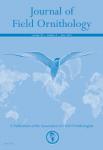Factors influencing detectability and responses of Elf Owls to playback of conspecific vocalizations
Broadcasting conspecific vocalizations is commonly used to survey secretive, inconspicuous, and uncommon species of birds, but information about how response behaviors vary across temporal and broad spatial gradients is limited for most species despite the importance of such data for guiding survey
efforts. We assessed response patterns and detection probability of Elf Owls (Micrathene whitneyi) across broad ecological gradients in the Sonoran and Chihuahuan deserts of Arizona that spanned much of their breeding range in the United States. From March to June 2015–2017, we examined response times and distances of an estimated 587 Elf Owls detected during playback surveys at 1488 stations along 121 transects (193 km). Additionally, from April to June 2010–2011 and 2016–2017, we examined detection probability during 255 playback experiments at occupied nests and modeled the influence of spatial, temporal, moon illumination, vegetation, conspecific densities, and weather-related factors on detection probability. During transect surveys,
response times were rapid (mean = 2.0 min), with 75% of detections within 3 min. Owls often responded close to broadcast stations (mean = 103 m), with only 25% of responses at distances > 140 m and none > 400 m. Response times were faster and from greater distances in the more arid western portion of our study area. During playback experiments at nests, detection probability averaged 0.65 and declined with increasing time of night, time of season, and noise levels. Detection probability also declined with increasing distance from target owls, but at lower rates in the western than the eastern portion of our study area. Spatial variation in detectability was primarily due to surveyors failing to detect responding owls in areas with higher owl densities in more resource-rich environments in the east, not differences in underlying responsiveness. Our results suggest that 5 or 6 min surveys within ~4 h of sunset and early in the breeding season will be most effective and that spacing survey stations from 100 to 150 m apart, depending on local densities and study objectives, is adequate for estimating occupancy and abundance with relatively low false absence rates.

